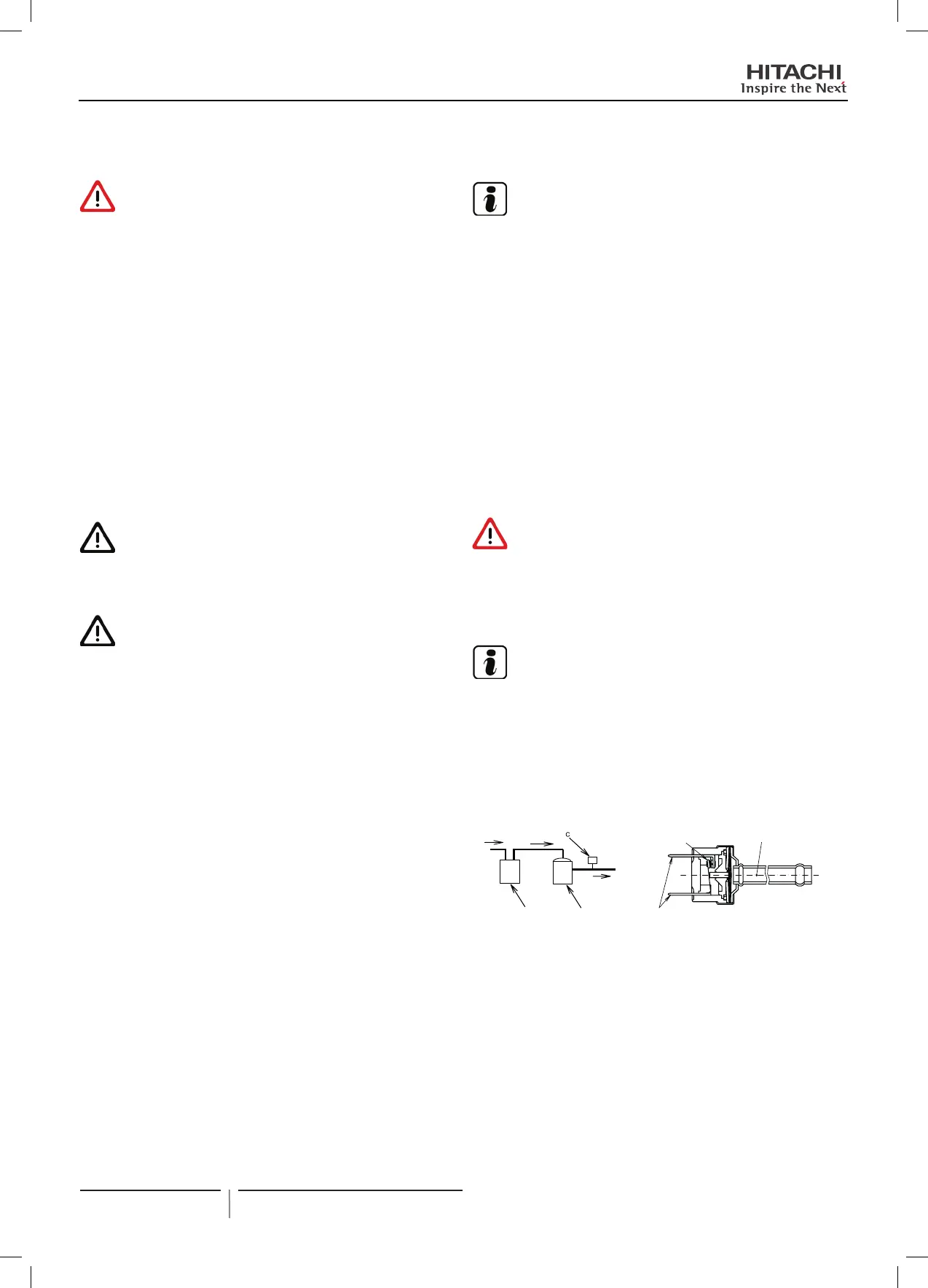1.3.2 Additional information about safety
DANGER
• HITACHI is not able to foresee all the circumstances
which may result in a potential danger.
• Do not pour water in the indoor or outdoor unit. These
products are tted with electric components. If water co-
mes into contact with electric components, this will cau-
se a serious electric shock.
• Do not handle or adjust the safety devices inside the in-
door and outdoor units. The handling or adjustment of
these devices may result in serious accident.
• Do not open the service cover or access panel of the in-
door and outdoor units without disconnecting the main
supply.
• In the event of re, switch off the mains, put out the re
immediately and contact your service supplier.
• Check that the earth cable is correctly connected.
• Connect the unit to a circuit breaker of the specied ca-
pacity.
CAUTION
This unit is designed for commercial and light industrial applica-
tion. If installed in household appliances, it could cause electro-
magnetic interference.
CAUTION
• Refrigerant leaks may hinder respiration as the gas displaces
the air in the room.
• Fit the indoor unit, the outdoor unit, the remote control and
the cable at a minimum of 3 metres away from sources of
strong radiation from electromagnetic waves, such as medical
equipment.
• Do not use sprays, such as insecticides, varnishes or enamels
or any other inammable gas within a metre of the system.
• If the circuit breaker or supply fuse of the unit comes on fre-
quently, stop the system and contact the service suppler.
• Do not carry out maintenance or inspection work yourself.
This work must be carried out by qualied service personnel
with suitable tools and resources for the work.
• Do not place any foreign material (branches, sticks, etc.) in
the air inlet or outlet of the unit. These units are tted with high
speed fans and contact with any object is dangerous.
• This appliance must be used only by adult and capable peo-
ple, having received the technical information or instructions
to handle this appliance properly and safely.
• Children should be supervised to ensure that they do not play
with the appliance.
• RAS-(8-54)FSXN1E(-P) and RAS-(5-36)FSXNH(E)(-P) out-
door units are designed for commercial use and for light in-
dustrial application. If installed in house hold appliance, it
could cause electromagnetic interference.
NOTE
• The air in the room should be renewed and the room venti-
lated every 3 or 4 hours.
• The system tter and specialist shall provide anti-leak safety
in accordance with local regulations.
• This air conditioner has been designed for standard air condi-
tioning for human beings. For use in other applications, please
contact your HITACHI dealer or service contractor.
1.3.3 Pressure vessel and safety device
This air conditioning equipment is tted with a high pressure ves-
sel in accordance with the directive on pressure equipment. The
recipient has been designed and tested prior to dispatch in ac-
cordance with said directive. In addition, in order to avoid abnor-
mal pressures in the equipment, a high pressure switch is tted
in the refrigerant system. This does not require any adjustment.
As a result, the air conditioning unit is protected against abnormal
pressures.
DANGER
Do not handle, modify or change the high pressure switch
in the air conditioning unit. If abnormally high pressure is
applied to the elements in the air conditioning unit refrige-
rant cycle, including the high pressure vessels, these could
explode resulting in serious injury or loss of life.
NOTE
• The label indicating compliance with the directive on pressure
equipment, the vessel category and capacity is located on the
vessel itself.
• The high pressure switch is marked on the electric circuit dia-
grams of the outdoor unit as PSH and is connected to the
printed circuit board PCB1 of the unit.
Technical specications of the high-pressure switch: See on Con-
trol and safety devices.
Start-up and operation:
• Check that all the stop valves are fully open.
• Check that there are no obstacles on the sides of the air con-
ditioning unit inlet/outlet before start-up and during operation.
During maintenance, the high pressure side should be checked
regularly. If the pressure is higher than the maximum permitted
pressure, stop the system and clean the heat exchanger or re-
move the cause of the excess pressure.
4
PMML0294A rev.2 - 07/2014
General information
PMML0294A_rev.2_02-2014.indb 4 14/07/2014 12:27:59

